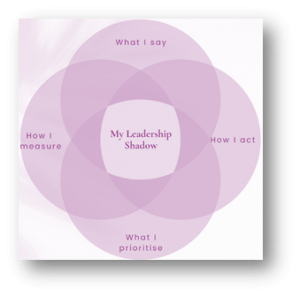All humans possess something oddly powerful in our neurology: mirror neurons.
These mirror neurons fire not only when we act— but also when we observe others acting.
You’ve likely heard the phrase “monkey see, monkey do”. That’s mirror neurons at work doing their thing. We have a natural tendency to mimic behaviour, both consciously and unconsciously.
This is incredibly powerful and very useful. It’s how children initially learn. By observing and copying those around them.
From childhood to adulthood, we continue this imitation instinct. Whether it’s picking up an accent or adopting workplace behaviours, our brains are wired to adapt to the environments and people around us.
And for leaders, this is where things get both fascinating—and dangerous.
You see, your people will be observing you. Taking it all in. Then quite subconsciously taking adaptive cues from you.
This is your “Leadership Shadow”.
“What you are shouts so loudly in my ears I cannot hear what you say.”
Ralph Waldo Emerson
YOUR LEADERSHIP SHADOW
Your Leadership Shadow, a term first devised by Goldman Sachs, is the imprint you leave on your team—not just through what you say, but far more through what you do, prioritise and measure.
Employees watch their leaders very closely. Continuously taking subconscious cues from their actions and behaviours.
This shadow can promote either positive, supportive environments, or breed stress, disengagement and burnout.
Leaders might say they care about work-life balance but send emails at midnight.
Or they may preach collaboration but reward competitive behaviour.
The result? Mixed signals, confusion and undermined trust.
LEADERSHIP SHADOWS IN ACTION
The Dark Shadow: Unintended Consequences
Take a manager who emails their team at all hours, saying, “Don’t feel pressured to respond right away.” Despite the disclaimer, employees still feel compelled to stay constantly connected. This contributes to stress, anxiety and can lead to burnout. Actions like these create a toxic environment where leaders inadvertently set unspoken expectations that undermine well-being.
Micromanagement can be an insidious “dark shadow” behaviour. Imagine a leader who insists on approving every version of a report before it progresses to the next stage. This may initially seem like a way to ensure quality. But it can quickly erode trust and autonomy cultivating an environment where fear, frustration, and disengagement replace initiative and collaboration.
The Light Shadow: Intentional Leadership
In contrast, a leader who sets clear working hours and models healthy boundaries sends a strong message that well-being is a priority. Similarly, a manager who seeks input, listens carefully and follows through on feedback builds trust and engagement.
Great “light shadow” leaders tend to listen actively and attentively during conversations. They will pause, maintain eye contact and give undivided attention to the person speaking. This behaviour may seem minor, but it signals respect, inclusion and psychological safety. And its ripple effect across an organisation can be profound.
These leaders align words and actions, creating an environment where employees feel empowered and supported. Their leadership shadow fosters transparency, collaboration and a shared sense of purpose.
“Leadership is not about being in charge. It is about taking care of those in your charge.”
Simon Sinek
HOW TO CAST A POSITIVE LEADERSHIP SHADOW
Here are four key areas to examine and adjust:

- What You Say: Verbal and Non-Verbal Communication
- Do your words align with your emotions and mindset? Are you setting the right context for conversations and framing issues constructively?
- Tip: Instead of saying, “Let me know if you need any help,” a light-shadow leader might say, “How can I support you?” This subtle shift demonstrates that help is genuinely available, not just an empty offer.
- How You Act: Behaviour in Practice
- Actions speak louder than words. Are you consistent in your behaviour across different situations? Are you building relationships and setting a standard for how work gets done?
- Tip: Set a consistent example by demonstrating calmness under pressure. For instance, when a project hits an unexpected snag, instead of assigning blame or panicking, light-shadow leaders focus on solutions and finding a path forwards.
- What You Prioritise: Time and Focus
- Where you invest your time reveals what matters most. Do you prioritise meetings, planning or reactive “firefighting”?
- Tip: Positive Shadow leaders prioritise “walking the floor” or informal one-on-ones. They take time to connect with team members on a personal level, not just when there’s a problem to solve or when there’s a scheduled “social event”.
- How You Measure: Metrics and Accountability
- What do you choose to track and reward? Are you focused only on output or also on the journey – progress to milestones, improvements, well-being and collaboration along the way?
- Tip: Leaders with a light shadow will ask: “What signals are we sending with the metrics we track?” They seek to ensure that metrics align with both business goals and cultural values, creating an environment where well-being and performance coexist.
“What you do has far greater impact than what you say.”
Stephen Covey
LEADERSHIP IN ACTION: MANAGING YOUR SHADOW EFFECT
Leadership isn’t just about managing others; it starts with managing yourself.
As Viktor Frankl said, “When we are no longer able to change a situation, we are challenged to change ourselves.”
By being conscious of your leadership shadow, you can identify the blind spots that might be undermining your efforts.
There is no doubt that it takes courage and self-awareness to regularly ask: “What colour is my shadow, what role am I playing in my team’s success—or struggles?”
ILLUMINATE YOUR LEADERSHIP SHADOW WITH FPC
If you’re ready to cast a light leadership shadow, FPC’s expert Culture Mechanics can help.
Through coaching, feedback, and diagnostics, we’ll help you align your words, actions and priorities to cast the perfect shadow for a thriving, healthy, high-performing workplace.
Call us to ensure your leadership shadow reflects the future you want to build.
